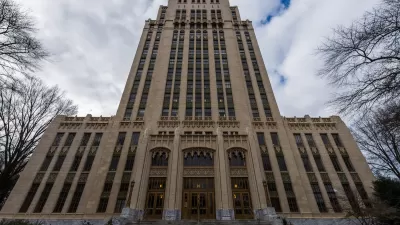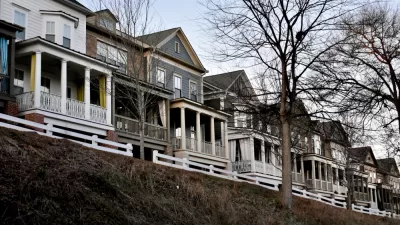Even if new housing is expensive, it can reduce overall housing prices by causing existing units to become more affordable.

While reading the Market Urbanism blog a few weeks ago, I noticed the following comment: “In cities with high rents and exclusivity, developers don't build low-income or affordable housing, they build to maximize their profits. That means simply a greater abundance of unaffordable housing.” In other words, housing prices are whatever developers want them to be: if a developer decides that it feels like charging a million dollars for a condominium, it can wave its Magic Wand of Luxury, and can forever find rich people who will gladly pay a million dollars.
But my own condo-buying experience suggests otherwise. In 2002, I bought a one-bedroom condominium in Atlanta for $133,000. On one hand, Atlanta is not one of the nation’s more expensive cities; on the other hand, my condo is in one of the city’s most affluent areas, Buckhead. The average house or condo value in Buckhead’s zip code is about half a million dollars—lower than in Manhattan, but higher than that of many outer-borough neighborhoods. In short, this is a high-demand zip code.
My condominium was certainly a luxury building when it was built. In addition to the pools and clubhouses common in Atlanta buildings, this building has a 24-hour doorman, a fairly unusual feature in Atlanta. So I would imagine that when my building got its first occupants in 1988, the developer did not think it would be “affordable housing” in any sense of the word.
But then the recession happened. The last time I checked, Zillow.com said that the condo was worth only $94,000, and that if someone bought it, he or she would pay $516 for the mortgage and property taxes (plus condo fees). My condo is certainly far more affordable than I had envisioned, even by Atlanta standards.
What happened? Of course, the recession reduced demand for housing in Atlanta. But according to the National Association of Home Builders, regional housing prices are only about 10 percent below their 2006 peak—far below my unit’s 30 percent drop.
More importantly, there seems to be a lot of newer housing in Buckhead; Zillow lists 126 condos for sale in zip code 30305; almost half of them were built after mine (which was built in 1988), and 45 of them were built after 2000. (By contrast, on New York’s 10023 zip code in the Upper West Side, only 30 of 291 units for sale were built after 1988.) Thus, it appears that Buckhead’s surge of new housing may have held down the price of older units such as mine.
It could be argued that because Atlanta is a low-cost city, its experiences are therefore irrelevant to those of more expensive cities. But in Atlanta, as in New York, new units are luxury units. Of the 45 condos for sale in my zip code built after 2000, not one is as cheap as mine. Only two of the condo units are being offered for less than $200,000 (though seven foreclosed units being put up for auction have lower “Zestimates,” which are Zillow’s guess of their value), and the median price is $375,000. Pre-2000 units are cheaper; five were less expensive than my $94,000 estimate, and ten foreclosures have lower Zestimates. The median price of pre-2000 units was slightly below $200,000. So in both Atlanta and New York, it appears that newer units are more expensive than older units.
It therefore seems to me that the law of supply and demand applies to housing even where new housing is significantly more expensive than older housing. The presence of new units holds down the price of older units by increasing the overall supply of housing and by making the older units less desirable in comparison. It logically follows that if any city builds (or allows the private sector to build) enough new housing, the desirability of new construction should make existing units more affordable. The only difference between a high-demand city and a low-demand city is that the city has to work harder to produce the new housing.

Alabama: Trump Terminates Settlements for Black Communities Harmed By Raw Sewage
Trump deemed the landmark civil rights agreement “illegal DEI and environmental justice policy.”

Study: Maui’s Plan to Convert Vacation Rentals to Long-Term Housing Could Cause Nearly $1 Billion Economic Loss
The plan would reduce visitor accommodation by 25% resulting in 1,900 jobs lost.

Planetizen Federal Action Tracker
A weekly monitor of how Trump’s orders and actions are impacting planners and planning in America.

Waymo Gets Permission to Map SF’s Market Street
If allowed to operate on the traffic-restricted street, Waymo’s autonomous taxis would have a leg up over ride-hailing competitors — and counter the city’s efforts to grow bike and pedestrian on the thoroughfare.

Parklet Symposium Highlights the Success of Shared Spaces
Parklets got a boost during the Covid-19 pandemic, when the concept was translated to outdoor dining programs that offered restaurants a lifeline during the shutdown.

Federal Homelessness Agency Places Entire Staff on Leave
The U.S. Interagency Council on Homelessness is the only federal agency dedicated to preventing and ending homelessness.
Urban Design for Planners 1: Software Tools
This six-course series explores essential urban design concepts using open source software and equips planners with the tools they need to participate fully in the urban design process.
Planning for Universal Design
Learn the tools for implementing Universal Design in planning regulations.
Caltrans
Smith Gee Studio
Institute for Housing and Urban Development Studies (IHS)
City of Grandview
Harvard GSD Executive Education
Toledo-Lucas County Plan Commissions
Salt Lake City
NYU Wagner Graduate School of Public Service






























